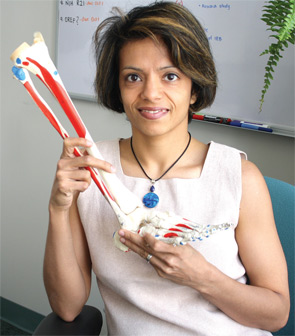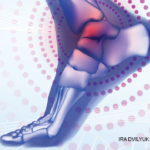Rheumatologists care for patients with assistive devices such as knee braces or foot orthotics. Although not involved in fitting patients with the appliances, rheumatologists still need to know how to manage these patients and evaluate how their assistive devices work to lessen pain and other problems.
“An orthotic is a device meant to assist a part of the body to achieve functional tasks,” says Howard Hillstrom, PhD, director of the Leon Root, MD, Motion Analysis Laboratory at the Hospital for Special Surgery in New York City. “Knee osteoarthritis [KOA] can be treated in many ways, ranging from pharmaceuticals to nutraceuticals, exercise, and surgery, when indicated. Orthotics is a part of our armamentarium and can address pain as well as its root causes.”
Malalignment, high body mass index (BMI), and tissue injury, such as torn ligaments, are the three major reasons for developing KOA and foot problems. Orthotics are designed to address these issues by improving alignment and redistributing joint loads. Based on the concept that lower-extremity structure and function are related, improving structure should help alleviate functional problems.
Use Unsettled
Currently, the use of orthotic devices such as bracing and support remains unsettled. Clinical trials have not yet provided unequivocal evidence that allows practitioners to know exactly the role orthotics can play among patients with KOA and/or foot pathologies.
“I believe that, as a field, we are at a point where we think there may be some groups of patients who would benefit from orthotics,” says Smita Rao, PhD, assistant professor in the department of physical therapy at New York University. “The challenge for the future is identifying who these people are.”
In the interim, she thinks most clinicians tell their patients that, while the science remains contentious, they should try it and see if it works. It helps that the area of science that is the most settled is the one that suggests there are very few adverse effects to the use of orthotic devices. Treatment-based classification is being used more frequently to identify those who are good candidates for a specific device.
Compared with other options, the use of assistive devices is relatively inexpensive, which can be another consideration in the treatment of knee OA and various foot-related problems. More research is needed to clarify which patients may benefit from over-the-counter (OTC) technology and which will require custom-made orthoses.
Noncustom Device Use Growing
“One of the biggest changes over the last few years has been growing support in the literature for noncustom devices,” notes David Nolan, PT, DPT, MS, OCS, CSCS, clinical specialist at the Massachusetts General Hospital Sports Physical Therapy Department and associate clinical professor in Northeastern University’s Physical Therapy Department. “A number of studies show that there is not much variance between custom and noncustom orthoses.”
The availability of OTC braces and foot orthotics means that more people can afford these treatments. It has greatly opened the scope of options available in this space. It also tends to be easier to adjust these devices as a person’s needs change without having to get another new orthotic.
The efficacy of noncustom devices also has lead to an increase in the variety of appliance designs. They are now available in many different levels of cushioning and flexibility and in different types of fabric.
“Whatever the activity my patient would like to participate in, I can now get a reasonably priced device that will be appropriate to their needs,” says Dr. Rao. “Having devices that are well engineered and made with very high-quality material available off the shelf is one of the most exciting developments we have seen recently.”
Do Not Oversell
It is important that physicians and others on the treatment team do not oversell the benefits of using orthotics when talking to their patients.
“I tell my patients right up front that I can help with the pain, but I can’t cure the arthritis,” says Erick Janisse, CO, CPed, vice-president at National Pedorthic Services, Inc., in Milwaukee. “My absolute best-case scenario is that we might be able to slow the arthritis’ progression down a little.”
Dr. Hillstrom notes that there is, as of yet, no literature showing that orthotics can stop progression of knee OA. This is the current “Holy Grail” of osteoarthritis research.
One area where there is agreement is that the proper use of orthotics can be useful in lessening pain.
Less Pain

“We have done research showing that bracing and foot orthotics can result in mean pain reductions of 30% or more on visual analog scales,” says Dr. Hillstrom. “That level is greater than what is seen with most analgesics and antiinflammatory medications. Still, the preliminary findings need to be supported by randomized, controlled trials.”
Their use may not be quite as grey when discussing the use of foot orthotics and special shoes.
“Good literature supports foot orthotic use in musculoskeletal pathologies,” says Dr. Nolan. “I think they are more effective when there is a component of the problem that is linked to biomechanics. If you have a foot type that is putting more load on one compartment of the knee, addressing the mechanics can certainly impact pathology.”
Lifestyle Fit
When making treatment decisions on referring patients for possible orthotic use, talk to the patient about how the appliance will fit in with their lifestyle. The best device in the world won’t work if it sits in the patient’s closet.
“I had a patient who did not think that a walking boot fit the image of a lawyer he wanted to project in the courtroom,” says Dr. Rao. “This is why the decisions on orthotic use have to be collaborative. There is no point in investing up to $400 in these devices if the patient isn’t going to wear it.”
Anybody with knee or foot arthritis can potentially benefit from the use of orthoses. Those where there is still some residual flexibility in the joint may have the best response.
“If a clinician can move a joint at least a little bit, that suggests that the joint can still be realigned with the help of a device,” says Dr. Hillstrom. “If somebody’s knee or foot is literally stiff, frozen like the Tin Man from the Wizard of Oz, then they might not be a good candidate. The orthotics need to be able to nudge the joint into an improved position of alignment.”
“In those who have an immobile foot, a device might actually cause an increase in load to their joints,” says Dr. Nolan. “Whatever joint problems they have already could be exacerbated.”
Orthotics is a part of our armamentarium and can address pain as well as its root causes.
—Howard Hillstrom, PhD
Assess Response
Rheumatologists should assess their patient’s response to the orthotic at every visit. In addition to an assessment of joint mobility and tenderness, ask about what causes them pain and if there have been any changes since the last visit.
There are a number of scales available. The Western Ontario and McMaster Universities Arthritis Index (WOMAC) measures five items for pain, two for stiffness, and 17 for functional limitation and is one of the more widely used measuring tools. The Knee injury and Osteoarthritis Outcome Score (KOOS) looks at pain, other symptoms, functioning in activities of daily living, function in sports and recreation, and knee-related quality of life.
The experts interviewed here emphasized that, when possible, it is best to talk about pain after the knees and feet have been stressed. Ask the patient to do something specific, such as walking up and down a half flight of steps first.
“Have them perturb the system by doing a task and then immediately afterward ask them about their pain intensity,” says Dr. Hillstrom. “There is not a lot of pain involved with watching football on the couch. What is much more interesting is if they complain about their knee killing them following dancing for two hours at someone’s wedding.”
Monitoring the fit and use of orthotics can be undertaken during the office visit. If the knee brace is too tight, there can be a concern about compromising circulation or throwing off a blood clot.
It is also possible that a previously well-fitted orthotic may become too loose. For example, the patient who had a high BMI can now get up and walk around more. They are soon 25 pounds lighter and need to have their brace adjusted.
Future Advances
“I think we will see more of the same over the next five years,” says Dr. Nolan. “As the noncustom devices gain greater acceptance, we will be seeing improvements in the materials being used and in manufacturing as well. I don’t see any quantum leaps in the future as much as I see fine tuning what is now available.”
The use of lighter materials will make braces less bulky and easier to hide under clothing. They also breathe better and don’t trap as much heat. There is more diversity in thickness and flexibility.
Dr. Rao thinks that wearable technology will be integrated into orthoses to a greater extent in the near future. Shoes may be able to change the stiffness of the walking surface to help those with foot or knee pain while walking on uneven surfaces. For those with diabetes, their shoes may beep to alert them to critical load or humidity levels.
New cloth is becoming available that can help with comfort issues as well. There are coated products that reduce shear anywhere in the orthotic.
“Off-loading the plantar pressures in the foot is only half of the equation,” says Mr. Janisse. “The other half is avoiding the shear forces that can results in blisters.”
Treatment planning is another area where major advances may be seen during the next five years. Although currently still in the early stages of testing, the use of lasers to make three-dimensional images of the foot or knee may help in further individualizing treatment. The experts also think that the development of treatment algorithms will improve outcomes overall.
For appropriate treatment, those interviewed agreed that it is not important for rheumatologists to be experts in the field.
“I don’t expect the physician to have the knowledge or the background to write a really detailed prescription,” says Mr. Janisse. “If they can tell the diagnosis and what they want the orthotic to achieve, they can leave the rest to me.” the rheumatologist
Kurt Ullman is a freelance writer based in Indiana.

